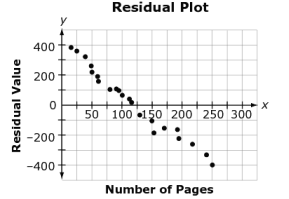- Fit a function to the data; use functions fitted to data to solve problems in the context of the data. Use given functions or choose a function suggested by the context. Emphasize linear, and exponential models.
- Informally assess the fit of a function by plotting and analyzing residuals.
- Fit a linear function for a scatter plot that suggests a linear association.
Remarks
Students take a more sophisticated look at using a linear function to model the relationship between two numerical variables. In addition to fitting a line to data, students assess how well the model fits by analyzing residuals.Clusters should not be sorted from Major to Supporting and then taught in that order. To do so would strip the coherence of the mathematical ideas and miss the opportunity to enhance the major work of the grade with the supporting clusters.
-
Also assesses:
- Assessment Limits :
In items that require the student to interpret or use the correlation
coefficient, the value of the correlation coefficient must be given in
the stem. - Calculator :
Neutral
- Clarification :
Students will represent data on a scatter plot.Students will identify a linear function, a quadratic function, or an
exponential function that was found using regression.Students will use a regression equation to solve problems in the
context of the data.Students will calculate residuals.
Students will create a residual plot and determine whether a function
is an appropriate fit for the data.Students will determine the fit of a function by analyzing the
correlation coefficient.Students will distinguish between situations where correlation does
not imply causation.Students will distinguish variables that are correlated because one is
the cause of another. - Stimulus Attributes :
Items should use real-world data and be set in a real-world context. - Response Attributes :
Items may require the student to apply the basic modeling cycle.Items may require the student to choose an appropriate level of
accuracy.Items may require the student to choose and interpret the scale in a
graphItems may require the student to choose and interpret units..
MAFS.912.S-ID.3.8
MAFS.912.S-ID.3.9
- Test Item #: Sample Item 1
- Question:
A company creates the equation y = 11.26x-76.1 to model the relationship between the number of pages in its catalog and the number of orders, in thousands, that were received.
To determine how well the equation models the relationship, the company plots the residuals as shown.

Why is the equation not a good model for the relationship?
Type your answer in the space provided.
- Difficulty: N/A
- Type: OR: Open Response
Related Courses
Related Access Points
Related Resources
Formative Assessments
Lesson Plans
Perspectives Video: Experts
Perspectives Video: Professional/Enthusiasts
Problem-Solving Task
Professional Development
Teaching Ideas
Tutorial
Unit/Lesson Sequence
Video/Audio/Animation
Virtual Manipulatives
STEM Lessons - Model Eliciting Activity
Students will be comparing hybrid-electric vehicles (HEV) versus gasoline-powered vehicles. They will research the benefits of owning a HEV while also analyzing the cost effectiveness.
Model Eliciting Activities, MEAs, are open-ended, interdisciplinary problem-solving activities that are meant to reveal students’ thinking about the concepts embedded in realistic situations. Click here to learn more about MEAs and how they can transform your classroom.
MFAS Formative Assessments
Students are given a set of data and are asked to use technology to create a scatter plot and write a function that fits the data set.
Students are asked to informally fit a line to model the relationship between two quantitative variables in a scatterplot, write the equation of the line, and use it to make a prediction.
Students are asked to compute, graph, and interpret the residuals associated with a line of best fit.
Students are asked to use a linear model to make and interpret predictions in the context of the data.
Student Resources
Perspectives Video: Experts
The tide is high! How can we statistically prove there is a relationship between the tides on the Gulf Coast and in a fresh water spring 20 miles from each other?
Download the CPALMS Perspectives video student note taking guide.
Type: Perspectives Video: Expert
Statistical analysis played an essential role in using microgravity sensors to determine location of caves in Wakulla County.
Download the CPALMS Perspectives video student note taking guide.
Type: Perspectives Video: Expert
Problem-Solving Task
This problem solving task asks students to examine the relationship between shops and crimes by using a correlation coefficient. The implications of linking correlation with causation are discussed.
Type: Problem-Solving Task
Video/Audio/Animation
Khan Academy tutorial video that demonstrates with real-world data the use of Excel spreadsheet to fit a line to data and make predictions using that line.
Type: Video/Audio/Animation
Virtual Manipulatives
Using this virtual manipulative, students are able to graph a function and a set of ordered pairs on the same coordinate plane. The constants, coefficients, and exponents can be adjusted using slider bars, so the student can explore the affect on the graph as the function parameters are changed. Students can also examine the deviation of the data from the function. This activity includes supplemental materials, including background information about the topics covered, a description of how to use the application, and exploration questions for use with the java applet.
Type: Virtual Manipulative
This is an online graphing utility that can be used to create box plots, bubble graphs, scatterplots, histograms, and stem-and-leaf plots.
Type: Virtual Manipulative
Parent Resources
Problem-Solving Task
This problem solving task asks students to examine the relationship between shops and crimes by using a correlation coefficient. The implications of linking correlation with causation are discussed.
Type: Problem-Solving Task
Video/Audio/Animation
Khan Academy tutorial video that demonstrates with real-world data the use of Excel spreadsheet to fit a line to data and make predictions using that line.
Type: Video/Audio/Animation









